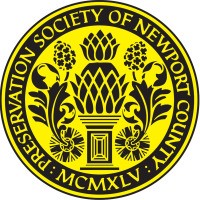Historical and Biographical Note
The Caleb Claggett House dates to around 1725 and stands at 22 Bridge Street in Newport’s Point neighborhood, which at the time of its construction was on the waterfront.
Notable clockmaker William Claggett (1694-1748), who lived at 16 Bridge Street in Newport, leased the plot of land on which the house stands to his father Caleb, a baker. The lease stipulated that within 25 years he was to build a house “36 ft. long and 18. ft broad and one bake house 40 ft. long and 20 ft. broad,” and furnish the materials “together with the locks, keys, Bolts, Staples, latches, Hooks, Hinges, Windows, door and glass […].” As part of the agreement, William would have access to a wharf on the property. The wharf and bake house are no longer extant.
The two-story house’s wooden frame with clapboards has brick end walls, with S-shaped iron supports. Despite the brick end, the chimney is central, a floor plan which is unique in Newport. The gambrel roof has a steep pitch and lean-to.
In the early nineteenth century, distiller Simon Newton owned the property, conveying it to his daughters Keziah Powers and Sarah Willson around 1808. The house seems to have been in the Powers family until John Powers and Mary Powers of Bellmont, Ohio sold it to Caleb Tripp in 1825. The house remained in the family of Tripp and his descendants for nearly eighty years, and so the house is also known as the Caleb Tripp House. Tripp’s descendent (possibly his daughter-in-law) Charlotte A. Tripp conveyed it to John A. Leary and Michael T. Leary in 1901; John A. Leary conveyed it to Thomas Martellino in 1914. The Martellino family held the property until 1955, when Paul A. Martellino sold it to Restorations Inc.
Restoration, Inc.’s purchase of the house in December 1955 most likely saved it from demolition. A few months later, Esther Wood Bates purchased the home. Restorations, Inc. completed the restoration. The Historic American Building Survey (HABS) documented the house around 1959. The house continues to be privately owned.
John Timothy Hopf (1920-2011) was a Newport-based photographer who chronicled the city’s history and buildings throughout much of the twentieth century. The Newport Mercury and Weekly News began publishing his photographs around 1940.
Hopf conducted his business from his home at 10 Red Cross Terrace. He published several books of his Newport photography, and many of the aerial photographs of Aquidneck Island published from the 1950s onward were taken by Hopf. His brochure Picturesque Newport – America’s First Resort in 1965 established his photography as part of the visual language of Newport’s tourism and commerce in the mid-twentieth century.
Throughout his career, Hopf was involved with the Preservation Society, photographing many of its properties and participating in The Elms Fair in 1977. Urban renewal work and development in Newport interested him and were frequent subjects of his work.


